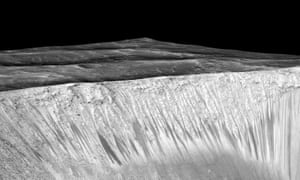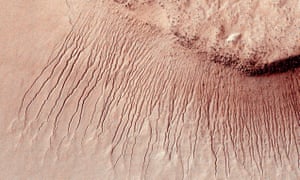Nasa scientists find evidence of flowing water on Mars
Liquid water runs down canyons and crater walls over the summer months onMars, according to researchers who say the discovery raises the chances of being home to some form of life.
The trickles leave long, dark stains on the Martian terrain that can reach hundreds of metres downhill in the warmer months, before they dry up in the autumn as surface temperatures drop.
Images taken from the Mars orbit show cliffs, and the steep walls of valleys and craters, streaked with summertime flows that in the most active spots combine to form intricate fan-like patterns.
Scientists are unsure where the water comes from, but it may rise up from underground ice or salty aquifers, or condense out of the thin Martian atmosphere.
“There is liquid water today on the surface of Mars,” Michael Meyer, the lead scientist on Nasa’s Mars exploration programme, told the Guardian. “Because of this, we suspect that it is at least possible to have a habitable environment today.”
The water flows could point Nasa and other space agencies towards the most promising sites to find life on Mars, and to landing spots for future human missions where water can be collected from a natural supply.
“Mars is not the dry, arid planet that we thought of in the past,” said Nasa’s Jim Green. “Liquid water has been found on Mars.”
Some of the earliest missions to Mars revealed a planet with a watery past. Pictures beamed back to Earth in the 1970s showed a surface crossed by dried-up rivers and plains once submerged beneath vast ancient lakes. Earlier this year, Nasa unveiled evidence of an ocean that might have covered half of the planet’s northern hemisphere in the distant past.
But occasionally, Mars probes have found hints that the planet might still be wet. Nearly a decade ago, Nasa’s Mars Global Surveyor took pictures of what appeared to be water bursting through a gully wall and flowing around boulders and other rocky debris. In 2011, the high-resolution camera on Nasa’s Mars Reconnaissance Orbiter captured what looked like little streams flowing down crater walls from late spring to early autumn. Not wanting to assume too much, mission scientists named the flows “recurring slope lineae” or RSL.
Researchers have now turned to another instrument on board the Mars Reconnaissance Orbiter to analyse the chemistry of the mysterious RSL flows.Lujendra Ojha, of Georgia Institute of Technology in Atlanta, and his colleagues used a spectrometer on the MRO to look at infrared light reflected off steep rocky walls when the dark streaks had just begun to appear, and when they had grown to full length at the end of the Martian summer.
Writing in the journal Nature Geosciences, the team describes how it found infra-red signatures for hydrated salts when the dark flows were present, but none before they had grown. The hydrated salts – a mix of chlorates and perchlorates – are a smoking gun for the presence of water at all four sites inspected: the Hale, Palikir and Horowitz craters, and a large canyon called Coprates Chasma.
“These may be the best places to search for extant life near the surface of Mars,” said Alfred McEwen, a planetary geologist at the University of Arizona and senior author on the study. “While it would be very important to find evidence of ancient life, it would be difficult to understand the biology. Current life would be much more informative.”
The flows only appear when the surface of Mars rises above -23C. The water can run in such frigid conditions because the salts lower the freezing point of water, keeping it liquid far below 0C.
“The mystery has been, what is permitting this flow? Presumably water, but until now, there has been no spectral signature,” Meyer said. “From this, we conclude that the RSL are generated by water interacting with perchlorates, forming a brine that flows downhill.”
John Bridges, a professor of planetary science at the University of Leicester, said the study was fascinating, but might throw up some fresh concerns for space agencies. The flows could be used to find water sources on Mars, making them prime spots to hunt for life, and to land future human missions. But agencies were required to do their utmost to avoid contaminating other planets with microbes from Earth, making wet areas the most difficult to visit. “This will give them lots to think about,” he said.
For now, researchers are focused on learning where the water comes from. Porous rocks under the Martian surface might hold frozen water that melts in the summer months and seeps up to the surface.
Another possibility is that highly concentrated saline aquifers are dotted around beneath the surface, not as pools of water, but as saturated volumes of gritty rock. These could cause flows in some areas, but cannot easily explain water seeping down from the top of crater walls.
A third possibility, and one favoured by McEwen, is that salts on the Martian surface absorb water from the atmosphere until they have enough to run downhill. The process, known as deliquescence, is seen in the Atacama desert, where the resulting damp patches are the only known place for microbes to live.
“It’s a fascinating piece of work,” Bridges said. “Our view of Mars is changing, and we’ll be discussing this for a long time to come.”
Mars
Distance to Earth: 225,300,000 km
Distance from Sun: 227,900,000 km
Radius: 3,390 km
Gravity: 3.711 m/s²
Surface area: 144,798,500 km²



